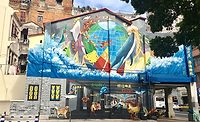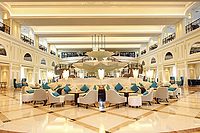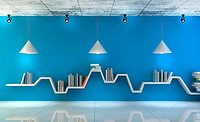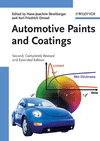Expansion of Color Space in Architectural Coatings

Point-of-sale (POS) paint tinting has been prevalent in the North American market for the last 50 years. The first POS system introduced by a Colortrend USA LLC predecessor company had a line-up of 12 colorants. These standard 12 colorants laid the cornerstone for the machine tinting and color system concept used globally. It is not uncommon for other color systems to have 9 or even 10 colorants, and in Europe, there are some systems containing as many as 16 colorants. Even though there is a wide variety in the number of colorants used, the ultimate color space or gamut is determined by the chroma (or brightness) of the organic colorants in the lineup. This color space incorporates colorants such as organic yellow, medium yellow, organic red, magenta, phthalo blue and phthalo green, with the lightness/darkness determined by the black and white.

|
| Table 1 Click to enlarge |
Due to new technology, colorant development has benefited from wider pigment choices leading to greater coverage of color space. In addition to pigment choices that lead to color space expansion, some of the newer pigments also provide better exterior durability and more opacity. As an added benefit, these new colorant choices are now being offered in zero-VOC and alkylphenol-ethoxylate (APE)-free systems to address environmental concerns.
Colortrend USA LLC has developed Colortrend® 808 and 808HP (High Performance) zero-VOC colorants, offering more than two dozen colorants to choose from. Table 1 provides a list of the colorants available, along with their respective canister codes, color index numbers and product descriptions.
To show the dramatic effect on the color gamut expansion that these new colorants have, a selection of high-performance colorants and the traditional standard 12 colorants were compared. For this comparison, the calculated absorption {K} and scattering {S} values were used to predict the theoretical total color gamut available. In this color visualization, colors are evenly spaced apart at a designated interval to represent the color gamut achieved. In Figures 1a and 1b, CIELAB a*b* plots, without regard to the lightness value, L*, are shown.

|
| Figure 1a and 1b Click to enlarge |
As shown in Figures 1a and 1b there is a large expansion in the yellow-red and blue-red quadrants, with a small broadening in the blue-green and yellow-green quadrants. The overall high colorant strength of the system is a much-needed benefit, providing increased opacity especially for neutral base colors. Overall, brighter, more vivid and deeper colors are achievable.
Colortrend Modules
With such a variety of colorants, custom combinations or “modules” have been prepared that can utilize 10, 12, even 16 canisters, based on customer requirements. Modules can be grouped into categories such as “Standard,” “Performance” and “Performance Plus.”

|
| Figure 2 Click to enlarge |
Standard Module
In the Standard Colortrend 808 module the colorants are coloristically equivalent to the 12 Colortrend 888 (glycol-containing) system colorants, making the transition from conventional to the environmentally friendly colorants very simple. In Figure 2, the colorants in this module are represented by their respective canister code.
Performance Module
In the Colortrend Performance module the traditional organic yellow {AXX}, organic red {R} and medium yellow {T} are replaced with HP organic yellow {AGF}, HP organic red {REE} and HP organic orange {ORE}, featuring a combination of standard, high-performance and high-strength colorants. Benefits include increased opacity, durability, fade resistance and expansion of color space. Figure 3 shows the colorants contained within this module.

|
| Figure 3 Click to enlarge |
Performance Plus Module
In the Colortrend Performance Plus module the traditional organic yellow {AXX}, organic red {R} and medium yellow {T} are replaced with HP organic yellow {AGF}, HP organic red {REE} and HP organic orange {ORE}. A violet {JXE} is added, and to keep this module to 12 colorants, the brown oxide {I} is removed. In addition, high-strength colorants are also used to provide higher opacity when needed.

|
| Figure 4 Click to enlarge |
Benefits include increased opacity, durability, fade resistance and expansion of color space. Figure 4 shows the colorants contained within this module.
An example of improved hiding power is a ‘fire-engine red’ color that typically requires as many as four coats of paint. With Colortrend 808 high-performance colorants, it can be obtained with one to two coats. The HP organic yellow {AGF} and HP organic orange {ORE} improve the fade resistance needed for exterior applications.
The color gamut of the Performance Plus module is the selection of colorants represented in Figure 1b and is compared to the Standard module represented in Figure 1a.

|
| Figure 5 Click to enlarge |
Façade Plus Module
By incorporating the cobalt green {IGE}, inorganic orange {IOE} and ultramarine blue {UBE} colorants along with the other inorganic colorants mentioned in the Façade module, the color space is expanded even further. The entire colorant lineup for this module is shown in Figure 6.
Façade colorants are suitable for silicate and silicone paints. For applications that require excellent durability, the Façade modules offer a wide range of hues that increase the color gamut tremendously.

|
| Figure 6 Click to enlarge |
Equal Volume Comparison
To demonstrate the wider color gamut now available, equal volume comparisons in three levels of TiO2-containing bases are shown in Figures 7a, b and c. The colorant modules used for the comparison are the Standard and Performance Plus. The colors that can be achieved in a tinted paint are determined by: base used, colorant loading and the colorant itself.

|
| Figure 7a-c Click to enlarge |
The a*b* two-dimensional color plots shown in Figures 7a-c were derived from empirical data using measurements of the single colorants prepared in each of the three bases presented. Drawdown panel measurements were taken using D65 illuminant, 10° observer, CIE L*a*b color space, sphere geometry instrument, and specular component included. Please note in this CIELAB a*b* two-dimensional color plot, the lightness is disregarded. These plots are used to demonstrate color gamut potential at maximum colorant loading for each base.
In the TiO2-containing bases, higher-strength colorants allow for an expanded number of colors achievable within a specific base. In Figures 7a-c, the HP yellow {AGF} and HP orange {ORE} replaced the standard yellow {AXX} and medium yellow {T} colorants, respectively, improving the fade resistance of these colors. A small portion of the color space is reduced without having the medium yellow {T} in the lineup; however, color space is expanded significantly with the addition of the organic orange {ORE}. The higher-strength red {REE}, blue {EXE}, green {DXE} and magenta {QME} colorants may allow colors to be formulated by using a higher opacity base since much lower quantities of colorants are required to achieve the same color. This results in an overall higher opacity for some of the colors leading to greater customer satisfaction, as fewer coats are needed. The color gamut comparisons provide good snapshots of extended color space attainable in each base.

|
| Figure 8a, 8b Click to enlarge |
In the neutral base, deeper, stronger and more vibrant colors can be achieved while increasing opacity, since the amount of total pigment contained within the colorants is substantially higher. While the high strength of the colorants contributes to the opacity, the expanded gamut results from the new pigments used in the colorants – orange, violet, greener blue, a cleaner magenta and a brighter red.
Vivid Expressions Collection
The use of colorants is best represented by color systems that consumers can visually appreciate. Colortrend® Vivid Expressions™ is a new color collection that offers 480 of the brightest, cleanest colors in the architectural coatings industry. Vivid Expressions provides the flexibility to expand an existing system or be used as a stand-alone POS system. Customers can take advantage of using Colortrend zero-VOC 808 HP colorants to update, expand and customize their color palette offering.
Figure 8a is a three-dimensional CIE L*a*b* color plot visualization of a typical color system created from the traditional 12 colorants. Figure 8b shows the traditional colors (green) plotted with Colortrend Vivid Expressions colors (blue) that were created using the high-performance colorants. The added vibrant colors, especially the selection of bright reds and the greater depth of violets, broaden the color space attained.
Summary
Flexibility in color choice and performance is essential for satisfying changing market demands and addressing regional trends. As seen in the color plots presented in this article, the Colortrend 808HP colorants expand color space potential while also improving the overall performance characteristics of the color in the finished coating.
With the Vivid Expressions collection, customers can update, expand or customize their existing color palette, offering the cleanest, brightest and best hiding colors in the industry today.
Looking for a reprint of this article?
From high-res PDFs to custom plaques, order your copy today!







